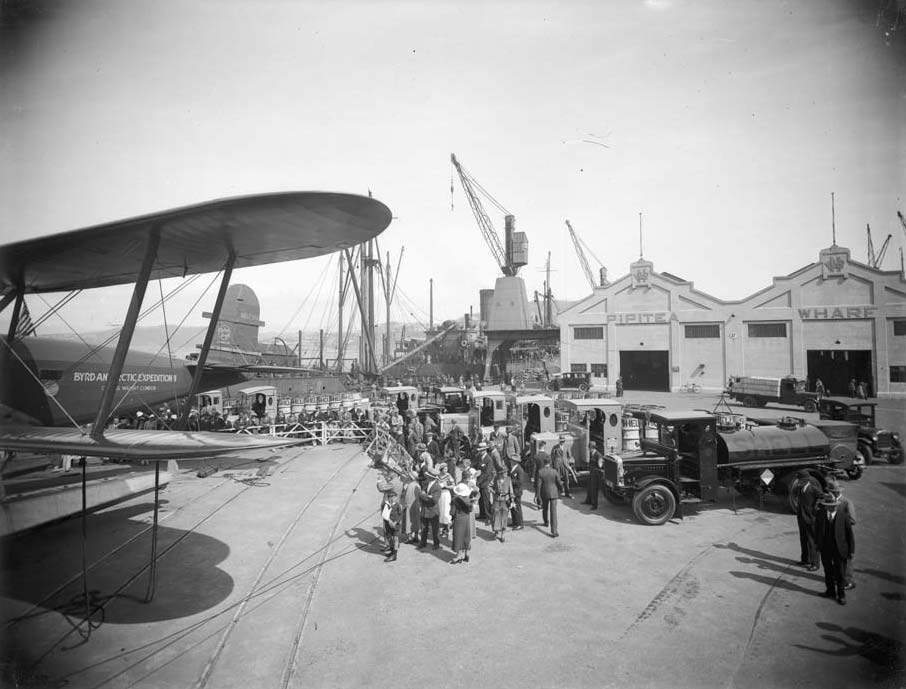
This photograph shows a crowd gathering to view the Byrd Expedition II's flagship Jacob Ruppert in Wellington. It was taken around 1933 by Sydney Charles Smith. A Curtiss Wright monoplane can be seen on board the ship.
Richard E. Byrd in New Zealand
American polar explorer and aviator Richard Byrd used New Zealand as a base for his Antarctic expeditions for 27 years. He was so moved by his experiences of the country and its people that he is said to have come to regard it as his second home.
Richard Byrd was born in Virginia, United States in 1888. He attended the University of Virginia before transferring to the United States Naval Academy in 1912. He developed a passion for flying while serving with the United States Navy during the First World War. Subsequently he became well known for his aeronautical exploits, notably a claimed flight over the North Pole in 1926. This enabled him to secure financial support for his first two Antarctic expeditions – both of which used New Zealand as a base and had New Zealanders as expedition members.
Scott memorial
On his first and last expeditions to the Antarctic Byrd laid wreaths at Scott’s memorial in Christchurch. Scott was Byrd’s boyhood hero – and continued to be so despite his own achievements in the Antarctic.
Byrd's first Antarctic expedition, the BAE1, took place between 1928 and 1930 and used Dunedin as its New Zealand base. His second expedition, the BAE2, took place between 1933 and 1935 and used Wellington as its New Zealand base. On both occasions Byrd was full of praise for the reception and assistance he and his men received in New Zealand. He was also very impressed with the New Zealand men he recruited as expedition members.
During the Second World War Byrd led another Antarctic expedition, this time backed by the United States government. The US Antarctic Service Expedition (1939-41) did not generate as much interest as his previous expeditions, as the New Zealand public was preoccupied with news of the war. Byrd also only visited the country for a few days at the beginning of the expedition. Eventually the expedition was abandoned altogether as an unnecessary wartime expense.
After the war the US mounted the largest Antarctic expedition to date - ‘Operation Highjump' (1946-47). Byrd was officer in charge of the expedition, although it was under the operational command of Admiral Richard Cruzens. Byrd went directly to the Antarctic from the US but visited New Zealand at the end of the expedition. Again he was full of praise for the reception he and his men received in New Zealand.
Byrd returned to New Zealand again in 1955 as the officer in charge of US Antarctic Programs. Again he was ostensibly in charge of Operation Deep Freeze I (1955-56), although it was under the operational command of Rear Admiral George Dufek. Prior to his final trip to the Antarctic - to await the historic first flight from New Zealand - Byrd commented once more on his feelings towards New Zealanders:
For the 27 years that I have been coming to New Zealand the friendliness and kindness have been unfailing. How could I help feeling a great affection for the people of New Zealand? As far as the United States is concerned in the family of nations New Zealanders are brothers.
Byrd died at his home in Boston in March 1957 and was buried in Arlington National Cemetery. In 1962 a memorial was erected on Mt Victoria, Wellington, in his honour.
Further information
Book
- A. Leigh Hunt, My second home: Admiral Byrd & New Zealand, A. Hunt, Wellington, 1968
Links
- Richard Evelyn Byrd (Wikipedia)
- Richard E. Byrd (South-Pole.com)



Community contributions